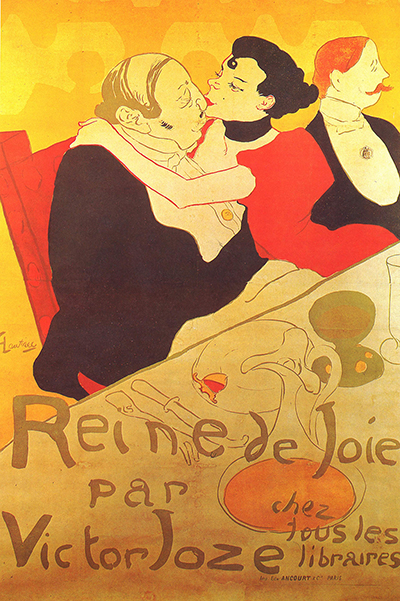The Reine de Joie depicts two men, and a woman seated at a dining table. The woman is dressed in a red dress complimented with a black choker. She embraces to her right, a stout elderly man whereas the other man gazes in the opposite direction.
The table is laid with cutlery, wine, an ewer, a plate, and water glasses. His first painting teacher was René Prince Toe, a friend of the Lautrec family. The reputation of Princeteau resulted from his description of the military and equestrian themes of the academic style of the 19th century. Toulouse-Lautrec worked very well with Prince Toe, but moved to Leon Bona's studio at the end of 1882.
The painting originates from France and is said to have been painted in 1892. Lithograph colour technique developed by German author and actor Alois Senefelder was used on the painting. This technique involves immiscibility of oil and water to come up with a painting. This method was used in medieval times and was a cheap and efficient way to come up with paintings. The painting is a reference to the troubled relations between the upper class and the working class of Paris. The man embraced in the photo has agreed to offer his wealth to the woman in the painting for nothing but her company. This setting provides an in-depth perspective on the transaction between wealthy men and lower-class women.
Edgar Degas inspired Henri de Toulouse-Lautrec's artworks. Degas used Japanese styles and impressions on his artworks. The artist was a human right activist as shown by some of his works. An example is the Elles printed in 1896. The painting highlights sex workers and is a plea for their rights. Other artworks of Henri de Toulouse-Lautrec include the Englishman at the Moulin Rouge and At the Moulin Rouge. These are among his most famous art pieces.
Toulouse-Lautrec was renowned for his humanistic and realistic depictions of women. At the end of the 19th and beginning of the 20th century, he influenced French art by using new themes, innovative styles and the ability to capture the essence of individuals with economic tools. His skill to transcend the expression of superficial reality and to better understand the psychological structure of his subject makes him an exceptional artist. Since 1892, he has used lithography as a suitable medium to achieve this goal.
Today, the artworks of Toulouse-Lautrec are considered remarkable. This, however, wasn't the case in the late nineteenth century. His father took a little interest in his son after the injury and thought his work was just a "sketch". Obsessed by these critics and obstructed by his immaturity, Toulouse-Lautrec insisted on appearing as a prolific artist whose work helped shape art for decades.




